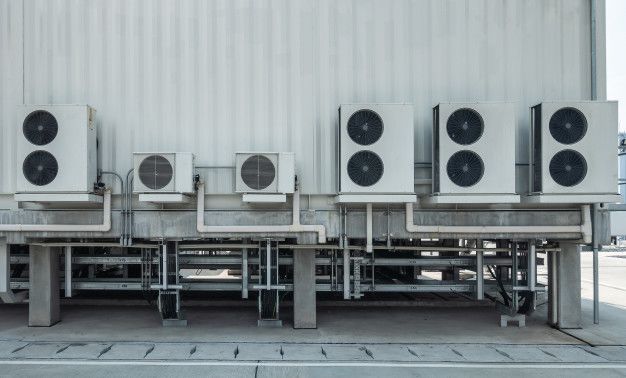Whether you’re considering a new commercial HVAC unit or simply upgrading your existing one, it’s crucial that you take into consideration its size and suitability for your building.
That’s because the size of a commercial HVAC system directly affects its performance, cost, and other maintenance factors. How to properly size a commercial HVAC unit involves intensive number crunching alongside knowledge of important HVAC principles.
How to Size Commercial HVAC
So, what’s the ideal method of how to determine the size of an HVAC unit in a commercial building or project? Let’s take a closer look.
First of all, you must consider factors such as:
- The difference between outside temperature and your desired indoor temperature range
- The building design and the amount of insulation in the ceiling, walls, and windows
- Position relative to the sun (for example, is it in a shaded area?)
- Average room size and total number of occupants
- Specific type and amount of lighting in the room (LED vs fluorescent)
- Activities in the room (cooking? hot baths?)
HVAC sizes are measured in tons - most commercial HVAC systems range between 2 tons and 30 tons. A 1-ton HVAC can remove around 12,000 BTU (British Thermal Units) of heat per hour. You will need to calculate the building's cooling load to know the appropriate capacity of the air conditioner to use.
As discussed earlier, your building's cooling load depends on several factors such as average external temperature to building design, orientation, and its primary purpose. However, a general rule of thumb is that it takes approximately 25 BTU to cool one square foot.
Here are some steps you can take for the purpose of a Rough estimate:
- First, calculate the square footage of the building space you want to cool.
- Divide the space area by 500.
- Multiply the result by 12,000 to get the approximate space cooling load in BTUs.
- Add about 380 BTU per occupant in the building, and 1,200 BTU for every kitchen.
- Add 1000 BTU to account for solar radiation in windows per window.
- Convert the number back to tons by dividing by 12,000 to get the size of the HVAC you need for your commercial building.
How to Determine the Size of the HVAC unit in a Commercial Building
Read this section to determine how to size commercial HVAC systems and save money. We’ve outlined a rough estimation of the cooling capacity that a commercial HVAC system would need based on data by EnergyStar.gov.
| Cooling Area (square feet) | HVAC Capacity Needed (BTUs per hour) | 350 sq.ft./ton |
| 2,000 ft.2 | 68,568 BTUs | 5.7 tons |
| 4,000 ft.2 | 137,143 BTUs | 11.4 tons |
| 8,000 ft.2 | 274,286 BTUs | 22.8 tons |
| 16,000 ft.2 | 548,572 BTUs | 48.6 tons |
Air Conditioner Sizing is Critical for Performance, Energy Efficiency, and Low Installation Costs
Bigger isn’t always better - an oversized commercial HVAC can have adverse effects on heating and cooling. For example, your office space cooled by an oversized HVAC might have poor humidity control that would lead to occupant discomfort, the risk of asthma, and building mold.
The economic implications of oversized HVAC units are also significant because it contributes to energy wastage. This will lead to increased wear and tear, high installation costs, and frequent maintenance.
Similarly, undersized HVAC units are unable to cool the space efficiently. They’ll work harder to produce the requisite amount of cooled air, which means the compressor will be pushing its limits. Expect wear and tear, longer wait times for desired temperatures, and much higher energy costs.
| Read more about HVAC:
What is the proper tons per square foot requirement for commercial HVAC systems? How to estimate the cost of an HVAC system for a new construction project |
How to Size Commercial HVAC System
Let’s make your job easier - when it comes to commercial systems, many HVAC professionals prefer to use 1 ton per 350-400 sq foot of floor area as a general rule of thumb. This estimation comes in handy when contractors need a quick reference point of HVAC equipment size.
The estimation is, however, presumptive of the significant HVAC sizing factors mentioned earlier (from building design, to activity and type of lighting installed).
Heat load and cooling load calculations
Another thing you must take into consideration are heat load and cooling load calculations. That requires precise estimates for heat gain vs heat loss in your building. The procedures published by the Air Conditioning Contractors of America (ACCA) are useful for this purpose.
Heating load calculations help to estimate the amount of heat loss from the building during the coldest climates. In some cases internal heat sources such as occupants, lighting, and building activity can help to compensate for heat loss.
Cooling load calculations are for estimating the heat gain in a building during the hottest part of the day. Internal factors add to the cooling load, similar to what we outlined in the previous sections.
Heat flow rate calculations
You can also get an accurate HVAC sizing estimation by calculating the space heat gain (the amount of air entering the building) and the space cooling load (the amount of air that needs to be removed).
The space heat gain is the rate at which heat enters the building or is generated within it at a given point in time. For accuracy, you will have to factor in solar radiation through the windows, conduction through the roofs and walls, and heat generated by occupants, equipment, lighting, and appliances.
The ASHRAE Task Group developed a standard procedure for these calculations, known as the transfer function method (TFM). This method simplifies the cooling load and heating load calculations, and factors in all the other determinants that increase or reduce heat gain and heat loss.
The formula is based on conduction transfer functions for the walls, roof, occupants, and glazing and room transfer functions for lights, appliances, and other radiant components. This formula involves complex calculations that require special computer applications, as shown here.
The bottom line: how to size commercial HVAC systems effectively
You can calculate HVAC sizing by following industry best practices for cooling and heating load calculations. For accurate predictions, one must factor in the building's design and orientation, lighting, and type of windows, among other aspects.
Get your HVAC systems compliant with San Fran Building Code and reduce energy costs by 30% using UFAD

Ultimate Guide to California's Building Code for HVACs
When it comes to any new building or renovation project, it's vital to ensure your project meets all building code requirements. Understanding every...
Timber Construction Techniques for Your Next Project
When you think of modern construction methods, many people think that steel and concrete make the strongest buildings. However, wood - specifically,...
